Essay: Collaborative Partnerships in Early Childhood
VerifiedAdded on 2023/06/03
|21
|5921
|390
Essay
AI Summary
This essay critically analyzes the significance and effects of collaborative partnerships involving young children and their families within early childhood education settings. Drawing upon a range of academic and research-based literature, the essay examines the benefits of such partnerships for children, families, and professionals. It highlights how collaboration fosters positive communication, supports child development, enhances family involvement, and improves overall outcomes. Furthermore, the essay explores potential negative effects and challenges associated with collaborative partnerships, such as time constraints and cultural differences. Based on this analysis, the essay proposes a set of principles designed to ensure effective collaborative partnerships that build resilience and promote positive outcomes for young children and their families. For each principle, specific examples illustrate how these principles can be applied to achieve desirable consequences in practice. The essay emphasizes the importance of open communication, information sharing, mutual respect, and shared goals in fostering successful partnerships that benefit all stakeholders.
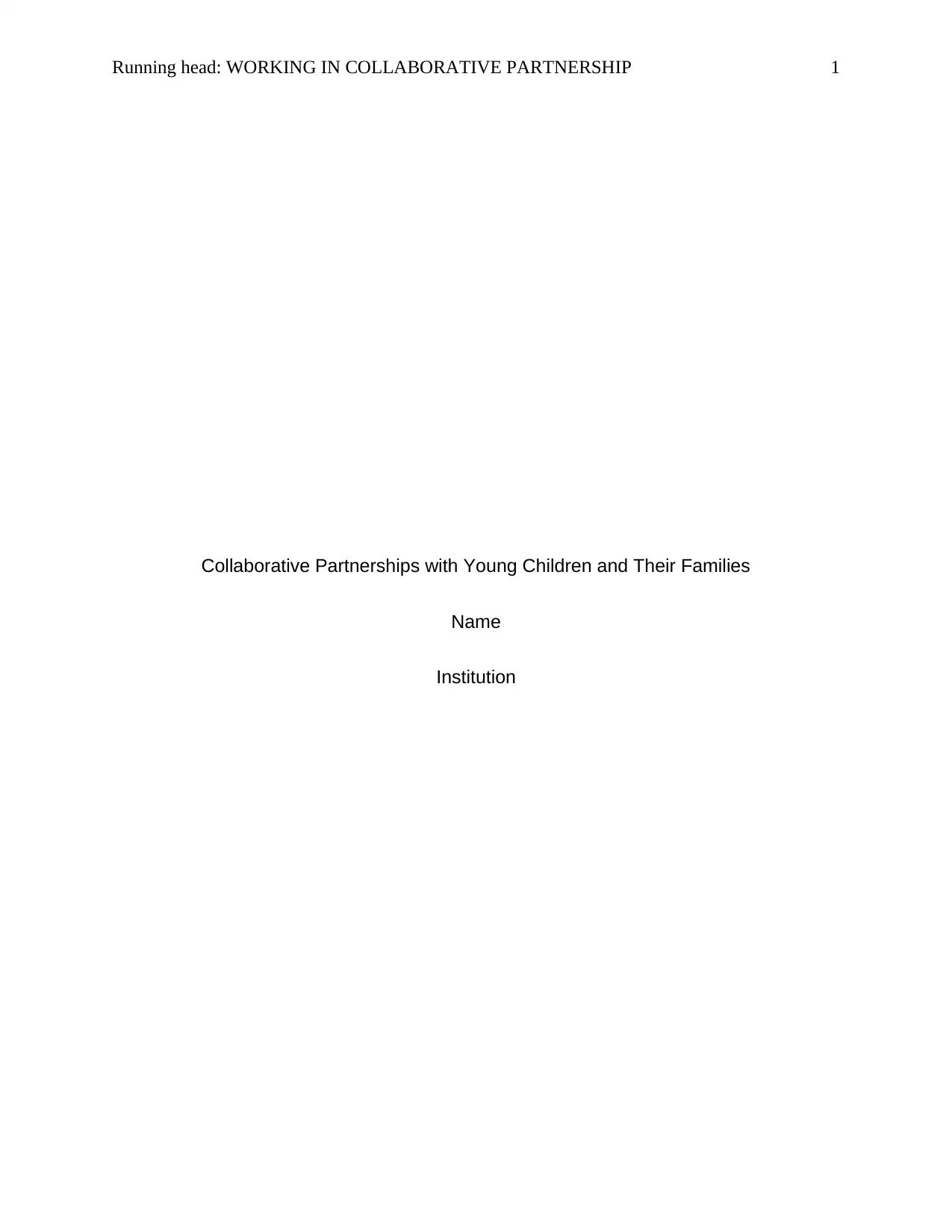
Running head: WORKING IN COLLABORATIVE PARTNERSHIP 1
Collaborative Partnerships with Young Children and Their Families
Name
Institution
Collaborative Partnerships with Young Children and Their Families
Name
Institution
Paraphrase This Document
Need a fresh take? Get an instant paraphrase of this document with our AI Paraphraser
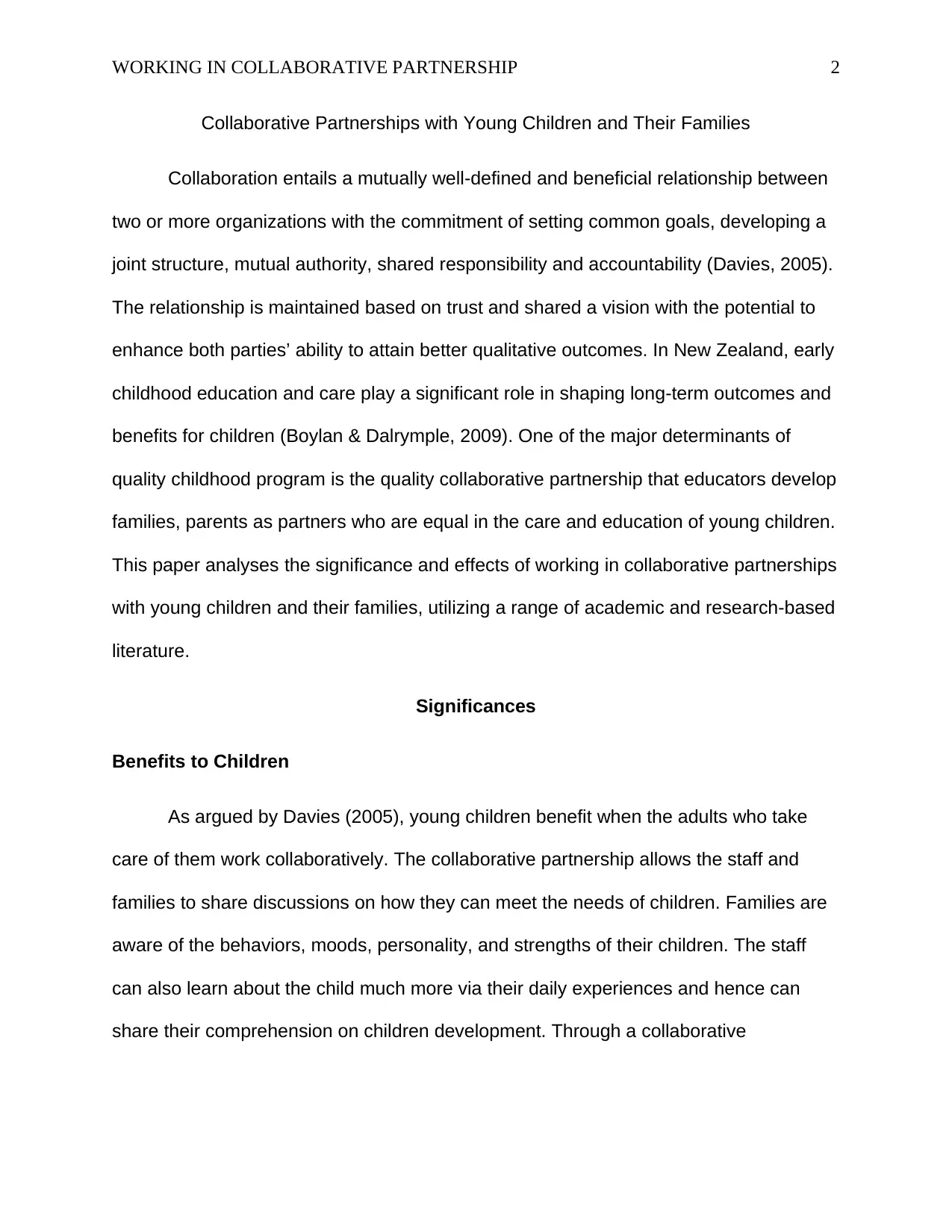
WORKING IN COLLABORATIVE PARTNERSHIP 2
Collaborative Partnerships with Young Children and Their Families
Collaboration entails a mutually well-defined and beneficial relationship between
two or more organizations with the commitment of setting common goals, developing a
joint structure, mutual authority, shared responsibility and accountability (Davies, 2005).
The relationship is maintained based on trust and shared a vision with the potential to
enhance both parties’ ability to attain better qualitative outcomes. In New Zealand, early
childhood education and care play a significant role in shaping long-term outcomes and
benefits for children (Boylan & Dalrymple, 2009). One of the major determinants of
quality childhood program is the quality collaborative partnership that educators develop
families, parents as partners who are equal in the care and education of young children.
This paper analyses the significance and effects of working in collaborative partnerships
with young children and their families, utilizing a range of academic and research-based
literature.
Significances
Benefits to Children
As argued by Davies (2005), young children benefit when the adults who take
care of them work collaboratively. The collaborative partnership allows the staff and
families to share discussions on how they can meet the needs of children. Families are
aware of the behaviors, moods, personality, and strengths of their children. The staff
can also learn about the child much more via their daily experiences and hence can
share their comprehension on children development. Through a collaborative
Collaborative Partnerships with Young Children and Their Families
Collaboration entails a mutually well-defined and beneficial relationship between
two or more organizations with the commitment of setting common goals, developing a
joint structure, mutual authority, shared responsibility and accountability (Davies, 2005).
The relationship is maintained based on trust and shared a vision with the potential to
enhance both parties’ ability to attain better qualitative outcomes. In New Zealand, early
childhood education and care play a significant role in shaping long-term outcomes and
benefits for children (Boylan & Dalrymple, 2009). One of the major determinants of
quality childhood program is the quality collaborative partnership that educators develop
families, parents as partners who are equal in the care and education of young children.
This paper analyses the significance and effects of working in collaborative partnerships
with young children and their families, utilizing a range of academic and research-based
literature.
Significances
Benefits to Children
As argued by Davies (2005), young children benefit when the adults who take
care of them work collaboratively. The collaborative partnership allows the staff and
families to share discussions on how they can meet the needs of children. Families are
aware of the behaviors, moods, personality, and strengths of their children. The staff
can also learn about the child much more via their daily experiences and hence can
share their comprehension on children development. Through a collaborative

WORKING IN COLLABORATIVE PARTNERSHIP 3
partnership, the staff and families can exchange information and focus on meeting the
needs of each child as well as support their development (May 2013).
The collaborative partnership provides children with the opportunity to see
significant people working together in their lives. Once children see positive
communication among their parents and staff or carer, they start learning how vital it is
to build healthy correlations (Davies, 2005). For instance, when children see parents
and carers are communicating well by being friendly with the staff, they begin to learn
that this how people relate (Peyton, 2017). Children can feel safe and trust the staff who
are supported and respected by their family and who support and respect their family in
return. Children at their service of early childhood and positive experiences experience
comfortability. Children feel important and valued when the staff and families respect
and support each other as well as take interest in their lives. Carers and parents can
also help difficulties of mental health when they when they work in collaborative
partnership (Wilder, 2013).
Working in collaborative partnership allows the staff and families to share their
experiences and understanding of how bonding is significant to children (Davies, 2005).
Young children are still developing and have trouble when they are separated from one
environment to another one. Working in partnership with staff and families can enable
children to negotiate the differences between settings like home and service of early
childhood by seeing the adults who take care of them working collaboratively (Sclafani,
2018).
Parents’ involvement in the schooling of children helps to create an ample
environment for children. Parents are more able to structure their experiences for
partnership, the staff and families can exchange information and focus on meeting the
needs of each child as well as support their development (May 2013).
The collaborative partnership provides children with the opportunity to see
significant people working together in their lives. Once children see positive
communication among their parents and staff or carer, they start learning how vital it is
to build healthy correlations (Davies, 2005). For instance, when children see parents
and carers are communicating well by being friendly with the staff, they begin to learn
that this how people relate (Peyton, 2017). Children can feel safe and trust the staff who
are supported and respected by their family and who support and respect their family in
return. Children at their service of early childhood and positive experiences experience
comfortability. Children feel important and valued when the staff and families respect
and support each other as well as take interest in their lives. Carers and parents can
also help difficulties of mental health when they when they work in collaborative
partnership (Wilder, 2013).
Working in collaborative partnership allows the staff and families to share their
experiences and understanding of how bonding is significant to children (Davies, 2005).
Young children are still developing and have trouble when they are separated from one
environment to another one. Working in partnership with staff and families can enable
children to negotiate the differences between settings like home and service of early
childhood by seeing the adults who take care of them working collaboratively (Sclafani,
2018).
Parents’ involvement in the schooling of children helps to create an ample
environment for children. Parents are more able to structure their experiences for
⊘ This is a preview!⊘
Do you want full access?
Subscribe today to unlock all pages.

Trusted by 1+ million students worldwide
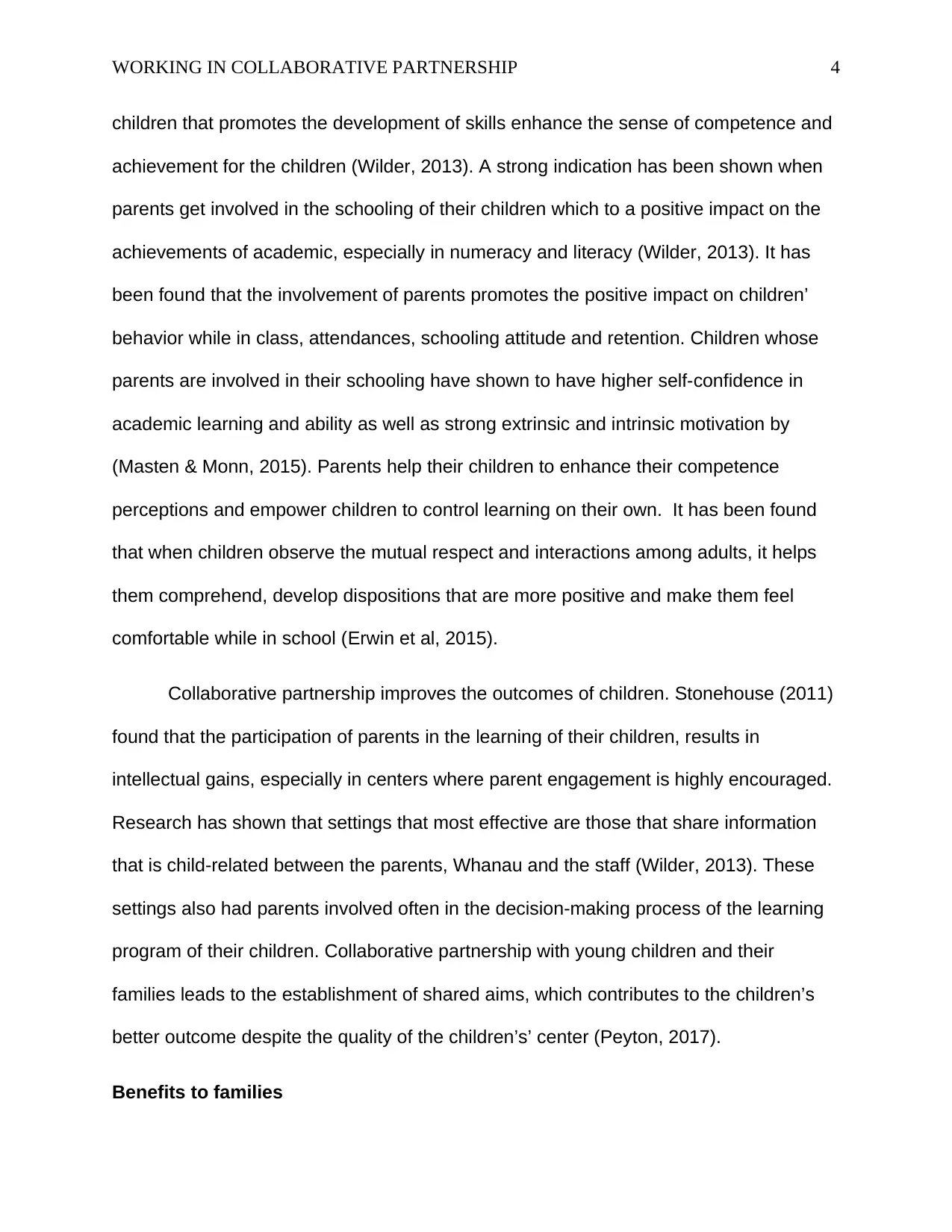
WORKING IN COLLABORATIVE PARTNERSHIP 4
children that promotes the development of skills enhance the sense of competence and
achievement for the children (Wilder, 2013). A strong indication has been shown when
parents get involved in the schooling of their children which to a positive impact on the
achievements of academic, especially in numeracy and literacy (Wilder, 2013). It has
been found that the involvement of parents promotes the positive impact on children’
behavior while in class, attendances, schooling attitude and retention. Children whose
parents are involved in their schooling have shown to have higher self-confidence in
academic learning and ability as well as strong extrinsic and intrinsic motivation by
(Masten & Monn, 2015). Parents help their children to enhance their competence
perceptions and empower children to control learning on their own. It has been found
that when children observe the mutual respect and interactions among adults, it helps
them comprehend, develop dispositions that are more positive and make them feel
comfortable while in school (Erwin et al, 2015).
Collaborative partnership improves the outcomes of children. Stonehouse (2011)
found that the participation of parents in the learning of their children, results in
intellectual gains, especially in centers where parent engagement is highly encouraged.
Research has shown that settings that most effective are those that share information
that is child-related between the parents, Whanau and the staff (Wilder, 2013). These
settings also had parents involved often in the decision-making process of the learning
program of their children. Collaborative partnership with young children and their
families leads to the establishment of shared aims, which contributes to the children’s
better outcome despite the quality of the children’s’ center (Peyton, 2017).
Benefits to families
children that promotes the development of skills enhance the sense of competence and
achievement for the children (Wilder, 2013). A strong indication has been shown when
parents get involved in the schooling of their children which to a positive impact on the
achievements of academic, especially in numeracy and literacy (Wilder, 2013). It has
been found that the involvement of parents promotes the positive impact on children’
behavior while in class, attendances, schooling attitude and retention. Children whose
parents are involved in their schooling have shown to have higher self-confidence in
academic learning and ability as well as strong extrinsic and intrinsic motivation by
(Masten & Monn, 2015). Parents help their children to enhance their competence
perceptions and empower children to control learning on their own. It has been found
that when children observe the mutual respect and interactions among adults, it helps
them comprehend, develop dispositions that are more positive and make them feel
comfortable while in school (Erwin et al, 2015).
Collaborative partnership improves the outcomes of children. Stonehouse (2011)
found that the participation of parents in the learning of their children, results in
intellectual gains, especially in centers where parent engagement is highly encouraged.
Research has shown that settings that most effective are those that share information
that is child-related between the parents, Whanau and the staff (Wilder, 2013). These
settings also had parents involved often in the decision-making process of the learning
program of their children. Collaborative partnership with young children and their
families leads to the establishment of shared aims, which contributes to the children’s
better outcome despite the quality of the children’s’ center (Peyton, 2017).
Benefits to families
Paraphrase This Document
Need a fresh take? Get an instant paraphrase of this document with our AI Paraphraser
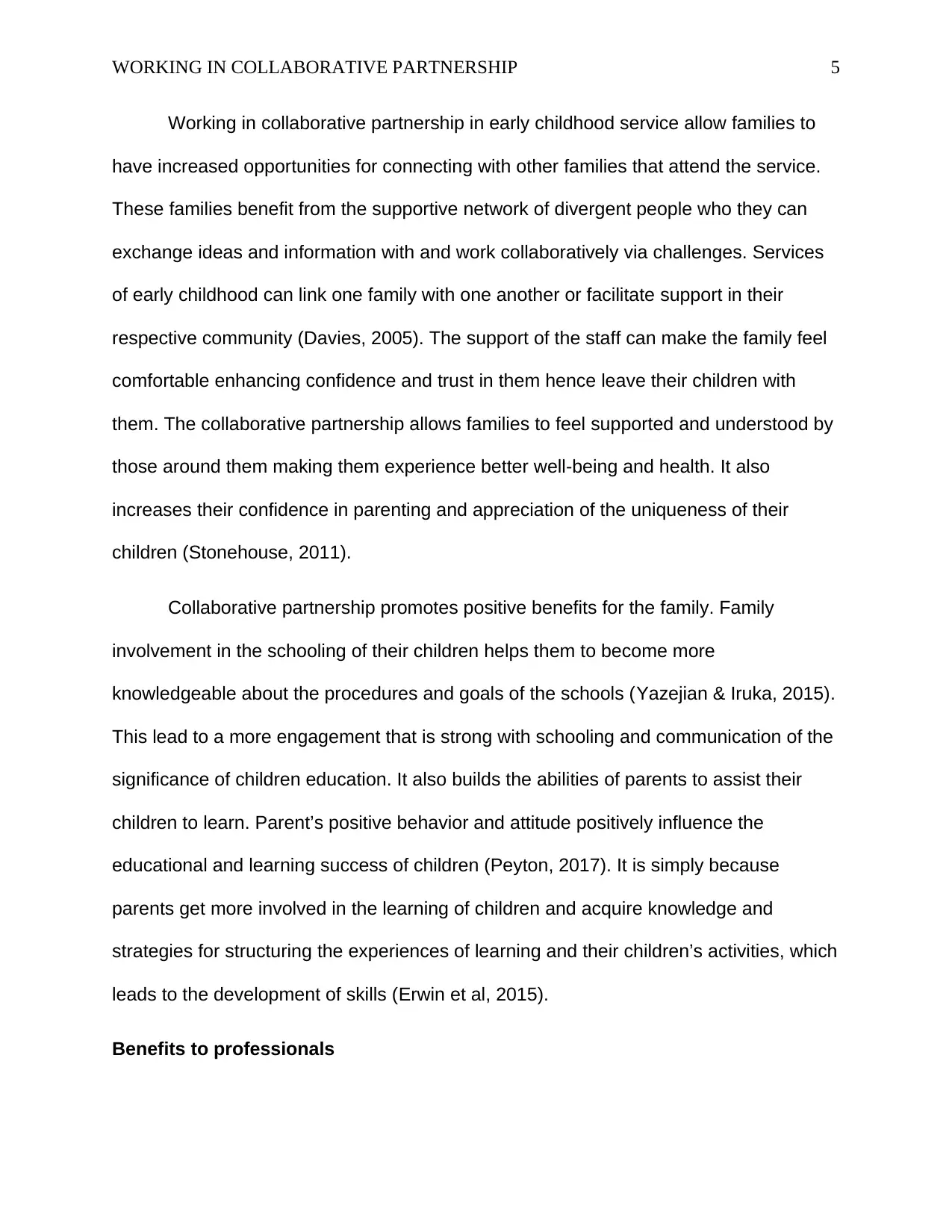
WORKING IN COLLABORATIVE PARTNERSHIP 5
Working in collaborative partnership in early childhood service allow families to
have increased opportunities for connecting with other families that attend the service.
These families benefit from the supportive network of divergent people who they can
exchange ideas and information with and work collaboratively via challenges. Services
of early childhood can link one family with one another or facilitate support in their
respective community (Davies, 2005). The support of the staff can make the family feel
comfortable enhancing confidence and trust in them hence leave their children with
them. The collaborative partnership allows families to feel supported and understood by
those around them making them experience better well-being and health. It also
increases their confidence in parenting and appreciation of the uniqueness of their
children (Stonehouse, 2011).
Collaborative partnership promotes positive benefits for the family. Family
involvement in the schooling of their children helps them to become more
knowledgeable about the procedures and goals of the schools (Yazejian & Iruka, 2015).
This lead to a more engagement that is strong with schooling and communication of the
significance of children education. It also builds the abilities of parents to assist their
children to learn. Parent’s positive behavior and attitude positively influence the
educational and learning success of children (Peyton, 2017). It is simply because
parents get more involved in the learning of children and acquire knowledge and
strategies for structuring the experiences of learning and their children’s activities, which
leads to the development of skills (Erwin et al, 2015).
Benefits to professionals
Working in collaborative partnership in early childhood service allow families to
have increased opportunities for connecting with other families that attend the service.
These families benefit from the supportive network of divergent people who they can
exchange ideas and information with and work collaboratively via challenges. Services
of early childhood can link one family with one another or facilitate support in their
respective community (Davies, 2005). The support of the staff can make the family feel
comfortable enhancing confidence and trust in them hence leave their children with
them. The collaborative partnership allows families to feel supported and understood by
those around them making them experience better well-being and health. It also
increases their confidence in parenting and appreciation of the uniqueness of their
children (Stonehouse, 2011).
Collaborative partnership promotes positive benefits for the family. Family
involvement in the schooling of their children helps them to become more
knowledgeable about the procedures and goals of the schools (Yazejian & Iruka, 2015).
This lead to a more engagement that is strong with schooling and communication of the
significance of children education. It also builds the abilities of parents to assist their
children to learn. Parent’s positive behavior and attitude positively influence the
educational and learning success of children (Peyton, 2017). It is simply because
parents get more involved in the learning of children and acquire knowledge and
strategies for structuring the experiences of learning and their children’s activities, which
leads to the development of skills (Erwin et al, 2015).
Benefits to professionals
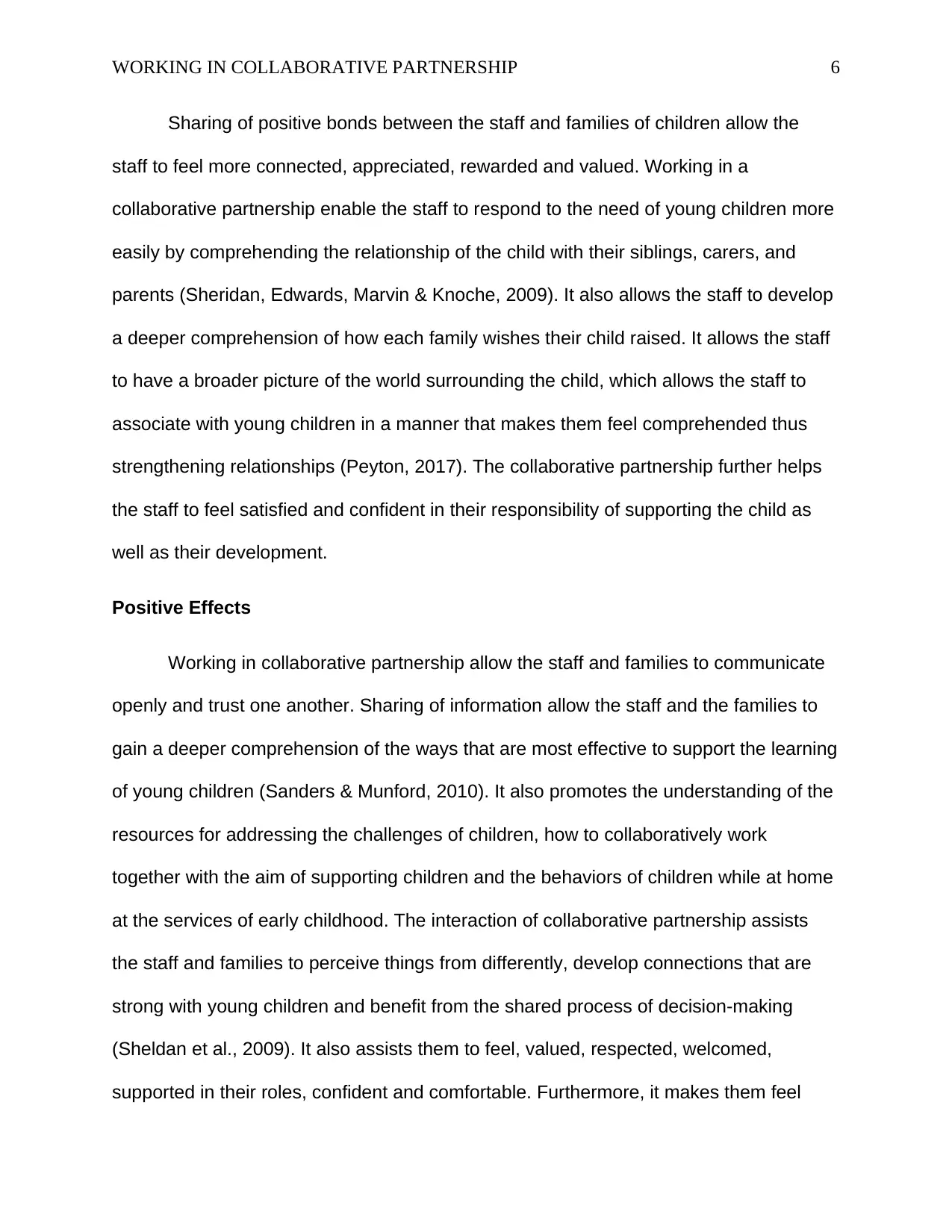
WORKING IN COLLABORATIVE PARTNERSHIP 6
Sharing of positive bonds between the staff and families of children allow the
staff to feel more connected, appreciated, rewarded and valued. Working in a
collaborative partnership enable the staff to respond to the need of young children more
easily by comprehending the relationship of the child with their siblings, carers, and
parents (Sheridan, Edwards, Marvin & Knoche, 2009). It also allows the staff to develop
a deeper comprehension of how each family wishes their child raised. It allows the staff
to have a broader picture of the world surrounding the child, which allows the staff to
associate with young children in a manner that makes them feel comprehended thus
strengthening relationships (Peyton, 2017). The collaborative partnership further helps
the staff to feel satisfied and confident in their responsibility of supporting the child as
well as their development.
Positive Effects
Working in collaborative partnership allow the staff and families to communicate
openly and trust one another. Sharing of information allow the staff and the families to
gain a deeper comprehension of the ways that are most effective to support the learning
of young children (Sanders & Munford, 2010). It also promotes the understanding of the
resources for addressing the challenges of children, how to collaboratively work
together with the aim of supporting children and the behaviors of children while at home
at the services of early childhood. The interaction of collaborative partnership assists
the staff and families to perceive things from differently, develop connections that are
strong with young children and benefit from the shared process of decision-making
(Sheldan et al., 2009). It also assists them to feel, valued, respected, welcomed,
supported in their roles, confident and comfortable. Furthermore, it makes them feel
Sharing of positive bonds between the staff and families of children allow the
staff to feel more connected, appreciated, rewarded and valued. Working in a
collaborative partnership enable the staff to respond to the need of young children more
easily by comprehending the relationship of the child with their siblings, carers, and
parents (Sheridan, Edwards, Marvin & Knoche, 2009). It also allows the staff to develop
a deeper comprehension of how each family wishes their child raised. It allows the staff
to have a broader picture of the world surrounding the child, which allows the staff to
associate with young children in a manner that makes them feel comprehended thus
strengthening relationships (Peyton, 2017). The collaborative partnership further helps
the staff to feel satisfied and confident in their responsibility of supporting the child as
well as their development.
Positive Effects
Working in collaborative partnership allow the staff and families to communicate
openly and trust one another. Sharing of information allow the staff and the families to
gain a deeper comprehension of the ways that are most effective to support the learning
of young children (Sanders & Munford, 2010). It also promotes the understanding of the
resources for addressing the challenges of children, how to collaboratively work
together with the aim of supporting children and the behaviors of children while at home
at the services of early childhood. The interaction of collaborative partnership assists
the staff and families to perceive things from differently, develop connections that are
strong with young children and benefit from the shared process of decision-making
(Sheldan et al., 2009). It also assists them to feel, valued, respected, welcomed,
supported in their roles, confident and comfortable. Furthermore, it makes them feel
⊘ This is a preview!⊘
Do you want full access?
Subscribe today to unlock all pages.

Trusted by 1+ million students worldwide
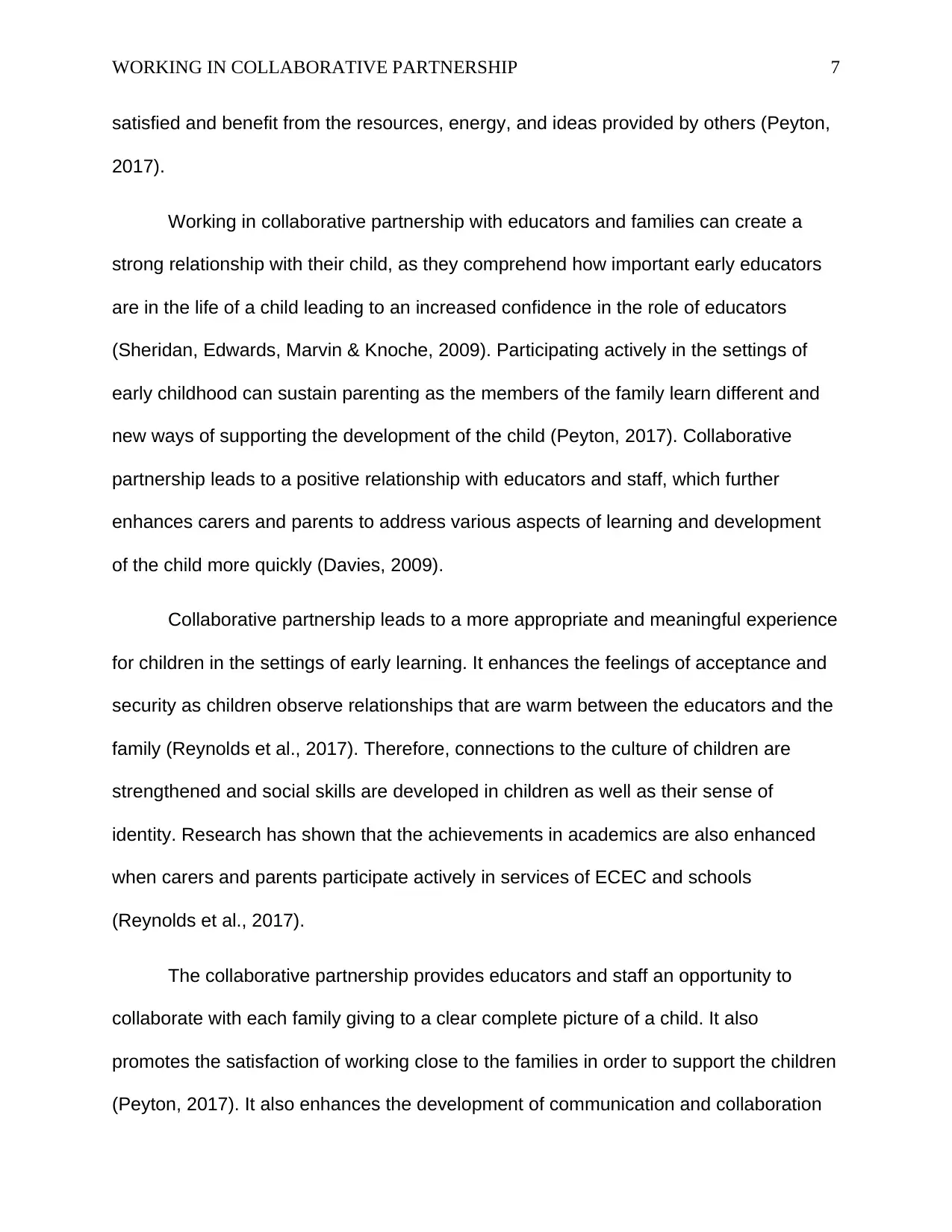
WORKING IN COLLABORATIVE PARTNERSHIP 7
satisfied and benefit from the resources, energy, and ideas provided by others (Peyton,
2017).
Working in collaborative partnership with educators and families can create a
strong relationship with their child, as they comprehend how important early educators
are in the life of a child leading to an increased confidence in the role of educators
(Sheridan, Edwards, Marvin & Knoche, 2009). Participating actively in the settings of
early childhood can sustain parenting as the members of the family learn different and
new ways of supporting the development of the child (Peyton, 2017). Collaborative
partnership leads to a positive relationship with educators and staff, which further
enhances carers and parents to address various aspects of learning and development
of the child more quickly (Davies, 2009).
Collaborative partnership leads to a more appropriate and meaningful experience
for children in the settings of early learning. It enhances the feelings of acceptance and
security as children observe relationships that are warm between the educators and the
family (Reynolds et al., 2017). Therefore, connections to the culture of children are
strengthened and social skills are developed in children as well as their sense of
identity. Research has shown that the achievements in academics are also enhanced
when carers and parents participate actively in services of ECEC and schools
(Reynolds et al., 2017).
The collaborative partnership provides educators and staff an opportunity to
collaborate with each family giving to a clear complete picture of a child. It also
promotes the satisfaction of working close to the families in order to support the children
(Peyton, 2017). It also enhances the development of communication and collaboration
satisfied and benefit from the resources, energy, and ideas provided by others (Peyton,
2017).
Working in collaborative partnership with educators and families can create a
strong relationship with their child, as they comprehend how important early educators
are in the life of a child leading to an increased confidence in the role of educators
(Sheridan, Edwards, Marvin & Knoche, 2009). Participating actively in the settings of
early childhood can sustain parenting as the members of the family learn different and
new ways of supporting the development of the child (Peyton, 2017). Collaborative
partnership leads to a positive relationship with educators and staff, which further
enhances carers and parents to address various aspects of learning and development
of the child more quickly (Davies, 2009).
Collaborative partnership leads to a more appropriate and meaningful experience
for children in the settings of early learning. It enhances the feelings of acceptance and
security as children observe relationships that are warm between the educators and the
family (Reynolds et al., 2017). Therefore, connections to the culture of children are
strengthened and social skills are developed in children as well as their sense of
identity. Research has shown that the achievements in academics are also enhanced
when carers and parents participate actively in services of ECEC and schools
(Reynolds et al., 2017).
The collaborative partnership provides educators and staff an opportunity to
collaborate with each family giving to a clear complete picture of a child. It also
promotes the satisfaction of working close to the families in order to support the children
(Peyton, 2017). It also enhances the development of communication and collaboration
Paraphrase This Document
Need a fresh take? Get an instant paraphrase of this document with our AI Paraphraser

WORKING IN COLLABORATIVE PARTNERSHIP 8
capacity among the staff and various families which come from diverse backgrounds. It
promotes the understanding of parents on the role of staff and educators, which makes
them, appreciate, respect and value them (Davies, 2009). There are also both long-term
and short-term gains to the communities as working in collaborative partnership is
strengthened in the community life (Clarkin-Phillips, 2012).
Negative effects
A collaborative partnership can pose various challenges to the family. They
include, difficulties of transport, time constraints, financial circumstances, cultural and
language differences, well-being and parent health, balancing older and younger’s
needs and feeling of not welcomed as a contributor (Sanders & Munford, 2010). The
staff and educators can experience working environments that are complex and time
constraints. The staff may also lack confidence in their professional expertise, face
challenges of cultural and language differences as well as have little comprehension of
engaging parents effectively (Wilder, 2009). Purdue (2009) argues that learning
outcomes of children and not being able to comprehend that maintaining and
developing a relationship is their responsibility. The staff and educators may also have
limited knowledge of the significance of family collaborative partnership (Purdue, 2009).
Set of Principles Arising from the Analysis
Positive communication with one another to support responsive relationship,
which can promote learning and development of children.
Research has shown the significance of effective communication between and
within various settings (Te, 2011). There are various strategies that can facilitate open
capacity among the staff and various families which come from diverse backgrounds. It
promotes the understanding of parents on the role of staff and educators, which makes
them, appreciate, respect and value them (Davies, 2009). There are also both long-term
and short-term gains to the communities as working in collaborative partnership is
strengthened in the community life (Clarkin-Phillips, 2012).
Negative effects
A collaborative partnership can pose various challenges to the family. They
include, difficulties of transport, time constraints, financial circumstances, cultural and
language differences, well-being and parent health, balancing older and younger’s
needs and feeling of not welcomed as a contributor (Sanders & Munford, 2010). The
staff and educators can experience working environments that are complex and time
constraints. The staff may also lack confidence in their professional expertise, face
challenges of cultural and language differences as well as have little comprehension of
engaging parents effectively (Wilder, 2009). Purdue (2009) argues that learning
outcomes of children and not being able to comprehend that maintaining and
developing a relationship is their responsibility. The staff and educators may also have
limited knowledge of the significance of family collaborative partnership (Purdue, 2009).
Set of Principles Arising from the Analysis
Positive communication with one another to support responsive relationship,
which can promote learning and development of children.
Research has shown the significance of effective communication between and
within various settings (Te, 2011). There are various strategies that can facilitate open
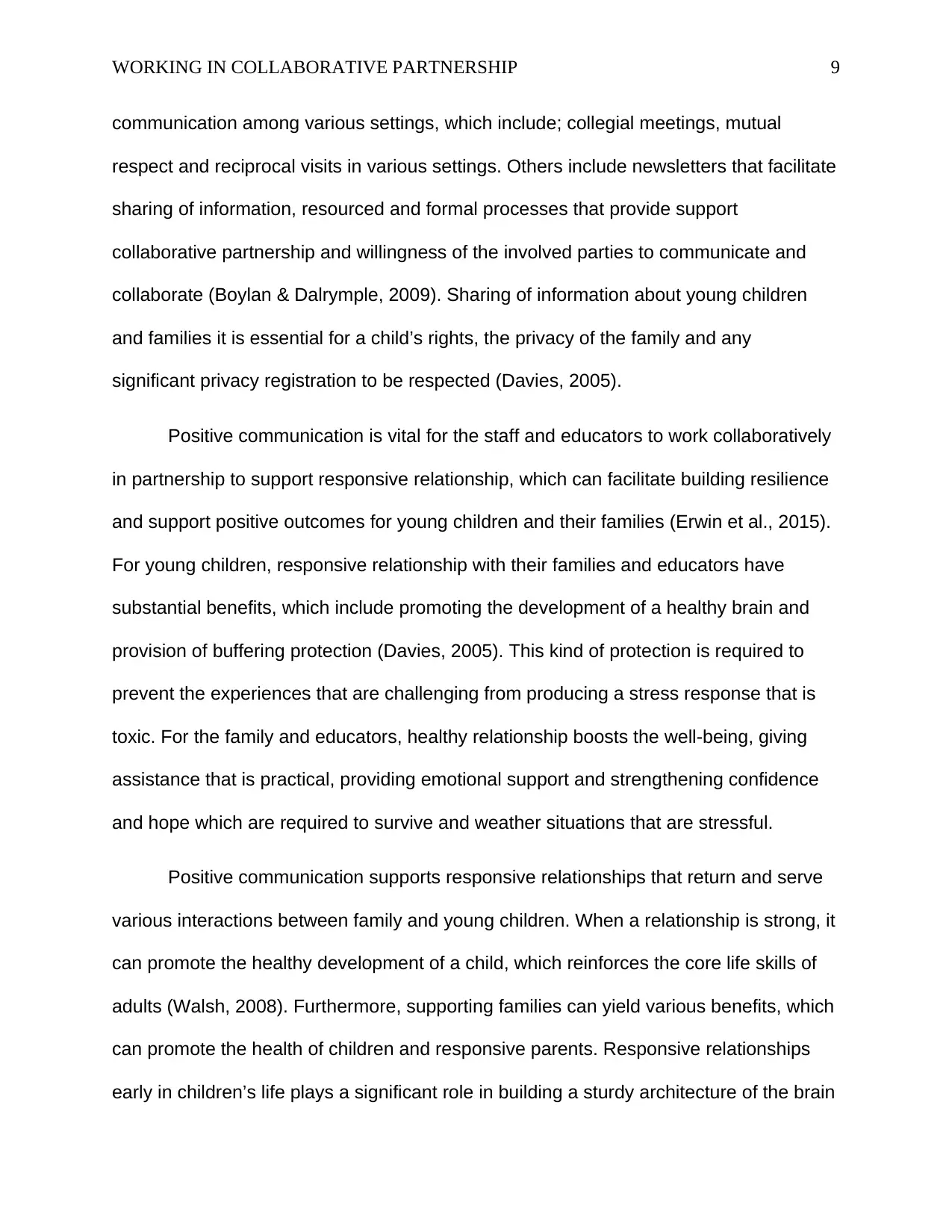
WORKING IN COLLABORATIVE PARTNERSHIP 9
communication among various settings, which include; collegial meetings, mutual
respect and reciprocal visits in various settings. Others include newsletters that facilitate
sharing of information, resourced and formal processes that provide support
collaborative partnership and willingness of the involved parties to communicate and
collaborate (Boylan & Dalrymple, 2009). Sharing of information about young children
and families it is essential for a child’s rights, the privacy of the family and any
significant privacy registration to be respected (Davies, 2005).
Positive communication is vital for the staff and educators to work collaboratively
in partnership to support responsive relationship, which can facilitate building resilience
and support positive outcomes for young children and their families (Erwin et al., 2015).
For young children, responsive relationship with their families and educators have
substantial benefits, which include promoting the development of a healthy brain and
provision of buffering protection (Davies, 2005). This kind of protection is required to
prevent the experiences that are challenging from producing a stress response that is
toxic. For the family and educators, healthy relationship boosts the well-being, giving
assistance that is practical, providing emotional support and strengthening confidence
and hope which are required to survive and weather situations that are stressful.
Positive communication supports responsive relationships that return and serve
various interactions between family and young children. When a relationship is strong, it
can promote the healthy development of a child, which reinforces the core life skills of
adults (Walsh, 2008). Furthermore, supporting families can yield various benefits, which
can promote the health of children and responsive parents. Responsive relationships
early in children’s life plays a significant role in building a sturdy architecture of the brain
communication among various settings, which include; collegial meetings, mutual
respect and reciprocal visits in various settings. Others include newsletters that facilitate
sharing of information, resourced and formal processes that provide support
collaborative partnership and willingness of the involved parties to communicate and
collaborate (Boylan & Dalrymple, 2009). Sharing of information about young children
and families it is essential for a child’s rights, the privacy of the family and any
significant privacy registration to be respected (Davies, 2005).
Positive communication is vital for the staff and educators to work collaboratively
in partnership to support responsive relationship, which can facilitate building resilience
and support positive outcomes for young children and their families (Erwin et al., 2015).
For young children, responsive relationship with their families and educators have
substantial benefits, which include promoting the development of a healthy brain and
provision of buffering protection (Davies, 2005). This kind of protection is required to
prevent the experiences that are challenging from producing a stress response that is
toxic. For the family and educators, healthy relationship boosts the well-being, giving
assistance that is practical, providing emotional support and strengthening confidence
and hope which are required to survive and weather situations that are stressful.
Positive communication supports responsive relationships that return and serve
various interactions between family and young children. When a relationship is strong, it
can promote the healthy development of a child, which reinforces the core life skills of
adults (Walsh, 2008). Furthermore, supporting families can yield various benefits, which
can promote the health of children and responsive parents. Responsive relationships
early in children’s life plays a significant role in building a sturdy architecture of the brain
⊘ This is a preview!⊘
Do you want full access?
Subscribe today to unlock all pages.

Trusted by 1+ million students worldwide
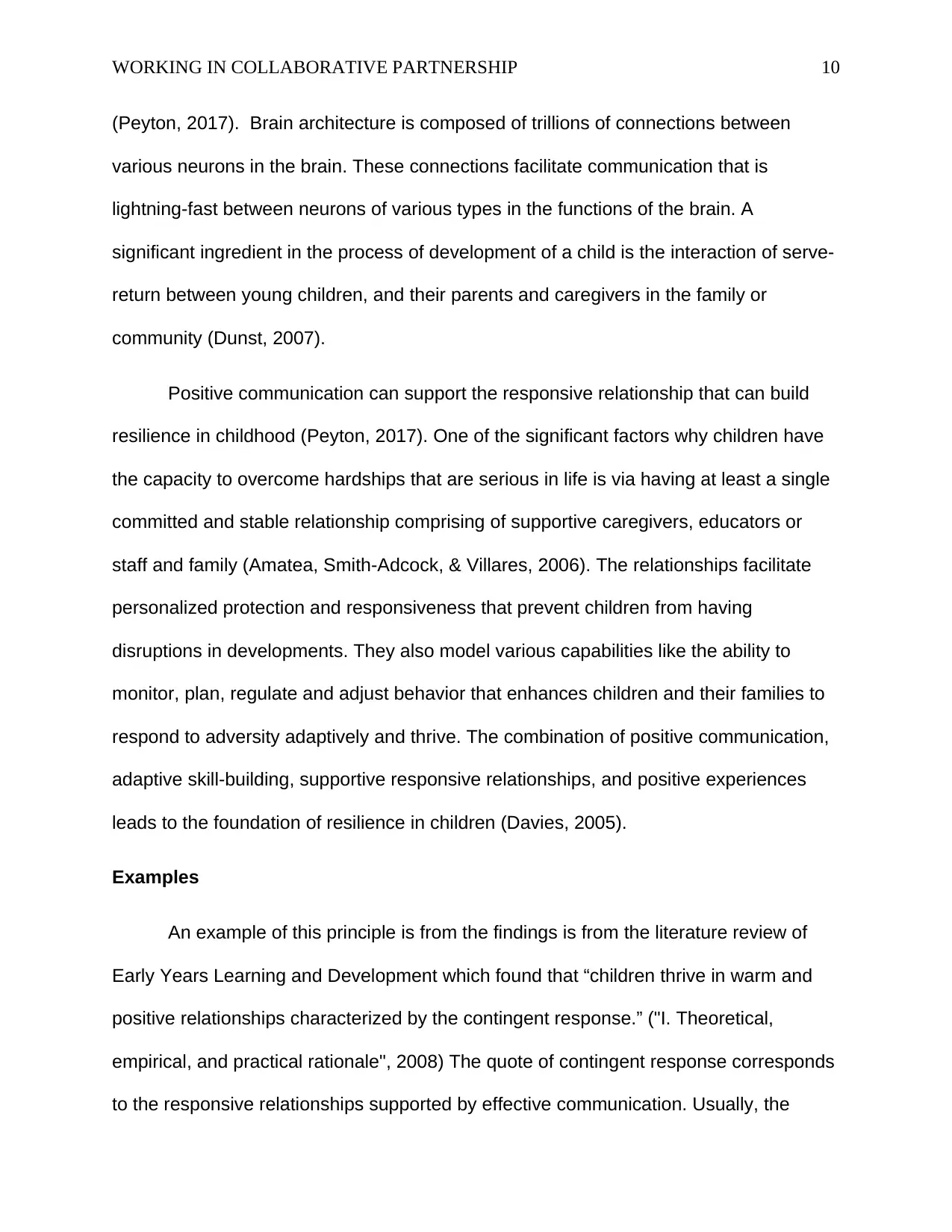
WORKING IN COLLABORATIVE PARTNERSHIP 10
(Peyton, 2017). Brain architecture is composed of trillions of connections between
various neurons in the brain. These connections facilitate communication that is
lightning-fast between neurons of various types in the functions of the brain. A
significant ingredient in the process of development of a child is the interaction of serve-
return between young children, and their parents and caregivers in the family or
community (Dunst, 2007).
Positive communication can support the responsive relationship that can build
resilience in childhood (Peyton, 2017). One of the significant factors why children have
the capacity to overcome hardships that are serious in life is via having at least a single
committed and stable relationship comprising of supportive caregivers, educators or
staff and family (Amatea, Smith-Adcock, & Villares, 2006). The relationships facilitate
personalized protection and responsiveness that prevent children from having
disruptions in developments. They also model various capabilities like the ability to
monitor, plan, regulate and adjust behavior that enhances children and their families to
respond to adversity adaptively and thrive. The combination of positive communication,
adaptive skill-building, supportive responsive relationships, and positive experiences
leads to the foundation of resilience in children (Davies, 2005).
Examples
An example of this principle is from the findings is from the literature review of
Early Years Learning and Development which found that “children thrive in warm and
positive relationships characterized by the contingent response.” ("I. Theoretical,
empirical, and practical rationale", 2008) The quote of contingent response corresponds
to the responsive relationships supported by effective communication. Usually, the
(Peyton, 2017). Brain architecture is composed of trillions of connections between
various neurons in the brain. These connections facilitate communication that is
lightning-fast between neurons of various types in the functions of the brain. A
significant ingredient in the process of development of a child is the interaction of serve-
return between young children, and their parents and caregivers in the family or
community (Dunst, 2007).
Positive communication can support the responsive relationship that can build
resilience in childhood (Peyton, 2017). One of the significant factors why children have
the capacity to overcome hardships that are serious in life is via having at least a single
committed and stable relationship comprising of supportive caregivers, educators or
staff and family (Amatea, Smith-Adcock, & Villares, 2006). The relationships facilitate
personalized protection and responsiveness that prevent children from having
disruptions in developments. They also model various capabilities like the ability to
monitor, plan, regulate and adjust behavior that enhances children and their families to
respond to adversity adaptively and thrive. The combination of positive communication,
adaptive skill-building, supportive responsive relationships, and positive experiences
leads to the foundation of resilience in children (Davies, 2005).
Examples
An example of this principle is from the findings is from the literature review of
Early Years Learning and Development which found that “children thrive in warm and
positive relationships characterized by the contingent response.” ("I. Theoretical,
empirical, and practical rationale", 2008) The quote of contingent response corresponds
to the responsive relationships supported by effective communication. Usually, the
Paraphrase This Document
Need a fresh take? Get an instant paraphrase of this document with our AI Paraphraser

WORKING IN COLLABORATIVE PARTNERSHIP 11
social and emotional development of the child is affected by intimate relationships.
Impairment of the function of the brain will influence the cognitive process of the child as
well as the emotional process (Sheldan et al., 2009). This principle can be applied in
practice in various ways. One example is developing practices of hiring aimed at
selecting and identifying the staff that is motivated build responsive relationships
through communicating positively with their clients such as in in the process of an
interview where candidates can be observed and in relation to each other (Walsh,
2012).
In another example of this principle is by Masten & Monn (2015) who argues that
connections that are stronger among microsystems contribute to the positive
development of greater potentiality. The concept is applicable in the education of early
childhood where an emphasis by Te Whariki is on the significance of building
responsive and respectful relationships between children, teachers and their families
(Masten & Monn 2015). In practice, this principle can be applied in service programs
where the staff and educators are provided with a significant amount of time to develop
enough relationships with young children. Research has shown that children who are
successful in academics, tend to come from families organized clearly where the role of
responsive relationships among family members is supported by positive and well-
defined communication (Te, 2011). A significant role is played by positive
communication in helping professionals and families coordinate their shared
responsibility of the wellbeing of children.
Family-centered practice that works together to reduce sources of stress and
advance knowledge.
social and emotional development of the child is affected by intimate relationships.
Impairment of the function of the brain will influence the cognitive process of the child as
well as the emotional process (Sheldan et al., 2009). This principle can be applied in
practice in various ways. One example is developing practices of hiring aimed at
selecting and identifying the staff that is motivated build responsive relationships
through communicating positively with their clients such as in in the process of an
interview where candidates can be observed and in relation to each other (Walsh,
2012).
In another example of this principle is by Masten & Monn (2015) who argues that
connections that are stronger among microsystems contribute to the positive
development of greater potentiality. The concept is applicable in the education of early
childhood where an emphasis by Te Whariki is on the significance of building
responsive and respectful relationships between children, teachers and their families
(Masten & Monn 2015). In practice, this principle can be applied in service programs
where the staff and educators are provided with a significant amount of time to develop
enough relationships with young children. Research has shown that children who are
successful in academics, tend to come from families organized clearly where the role of
responsive relationships among family members is supported by positive and well-
defined communication (Te, 2011). A significant role is played by positive
communication in helping professionals and families coordinate their shared
responsibility of the wellbeing of children.
Family-centered practice that works together to reduce sources of stress and
advance knowledge.

WORKING IN COLLABORATIVE PARTNERSHIP 12
The adoption of family-centered practice was developed by the early intervention
with families and their young children who had disabilities as its philosophical foundation
(Walsh 2013). This practice entails an emphasis on strengths, promotion of family
control and choice over resources that are desired and developing a relationship that is
collaborative between professionals and parents (Shonkoff & Fisher, 2013). This
principle has been associated with wide various benefits that have been demonstrated
in both parents and children. It has also brought more satisfaction where families have
found it to be more significant. The practice can also create a partnership with families
by advocating for respect and dignity, honoring their choices, values, and provision of
support that can enhance and strengthen the functioning of the family (Davies, 2005).
The family-centered practice has two components of participatory help-giving and
relational practices. Relational practices entail interpersonal behaviors like authenticity,
empathy, active listening, warmth and positive perceptions of parents (Srivastav,
Fairbrother & Simpson, 2017). These behaviors can help professionals to build
relationships that are effective with families. Studies on these behaviors have been
carried out especially on the literature on mental health. They have shown to have a
strong working alliance between professionals and parents, which are linked to positive
outcomes. Participatory behaviors are action-oriented and entail control and sharing
ways. Family information is shared by professionals by encouraging parents that to
make their informed decisions and use their capabilities and existing knowledge as well
as assisting families to acquire new skills through learning (Masten & Monn, 2015).
Family-centered practice can help parents to meet the essential needs of the
family which can help lower stress and support services in the community that support
The adoption of family-centered practice was developed by the early intervention
with families and their young children who had disabilities as its philosophical foundation
(Walsh 2013). This practice entails an emphasis on strengths, promotion of family
control and choice over resources that are desired and developing a relationship that is
collaborative between professionals and parents (Shonkoff & Fisher, 2013). This
principle has been associated with wide various benefits that have been demonstrated
in both parents and children. It has also brought more satisfaction where families have
found it to be more significant. The practice can also create a partnership with families
by advocating for respect and dignity, honoring their choices, values, and provision of
support that can enhance and strengthen the functioning of the family (Davies, 2005).
The family-centered practice has two components of participatory help-giving and
relational practices. Relational practices entail interpersonal behaviors like authenticity,
empathy, active listening, warmth and positive perceptions of parents (Srivastav,
Fairbrother & Simpson, 2017). These behaviors can help professionals to build
relationships that are effective with families. Studies on these behaviors have been
carried out especially on the literature on mental health. They have shown to have a
strong working alliance between professionals and parents, which are linked to positive
outcomes. Participatory behaviors are action-oriented and entail control and sharing
ways. Family information is shared by professionals by encouraging parents that to
make their informed decisions and use their capabilities and existing knowledge as well
as assisting families to acquire new skills through learning (Masten & Monn, 2015).
Family-centered practice can help parents to meet the essential needs of the
family which can help lower stress and support services in the community that support
⊘ This is a preview!⊘
Do you want full access?
Subscribe today to unlock all pages.

Trusted by 1+ million students worldwide
1 out of 21
Related Documents
Your All-in-One AI-Powered Toolkit for Academic Success.
+13062052269
info@desklib.com
Available 24*7 on WhatsApp / Email
![[object Object]](/_next/static/media/star-bottom.7253800d.svg)
Unlock your academic potential
Copyright © 2020–2025 A2Z Services. All Rights Reserved. Developed and managed by ZUCOL.





